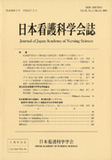Japanese
English
- 販売していません
- Abstract 文献概要
- 参考文献 Reference
- サイト内被引用 Cited by
要旨
本研究は,臨床の日常場面で交わされる患者─看護者の相互理解,相互行為の場面に焦点をあて,そこで生じる共感のプロセスを明らかにすることを目的とした質的帰納的な研究である.S市内の総合病院消化器内科病棟に勤務する看護者5名とその患者9名を対象に,患者─看護者の相互作用場面を参加観察法と半構成的質問紙による面接法を実施した.
その結果,患者─看護者関係における共感のプロセスとして3つの位相が明らかになった.第1の位相は,「共感の生じる前提条件」で各々が抱いている気がかりがあった.第2の位相は,「相互の関わりが段階的に発展して共感になっていくプロセス」で次の5つの段階からなっていた;1)関わりに専念するための準備,2)気がかりを探り合う,3)気がかりの焦点化,4)気がかりの内容理解に向けた相互の取り組み,5)各々が理解した内容の確認とその提示.第3の位相は,「プロセスの成果」で確かめ合った理解に動機づけられた援助と,効果の共有の2つの構成要素からなっていた.
以上の結果から,臨床において共感のプロセスを1つ1つたどることに意味があり,共感のプロセスをたどるそれ自体,患者にとって必要な援助になることが示唆された.
Abstract
The purpose of this qualitative study was to clarify the process of empathy which occurs in relationships between patients and nurses in the clinical setting. The participants in this study were 5 nurses and 9 patients on an internal medicine unit of a general hospital in S city. The data was collected using a participant observation and a semi-structured interview.
The findings of this study showed that the process of empathy in the patient-nurse relationship was found to consist of three different phases. The first phase:“the initial condition of empathy.” It consists of the concern in the mind of nurses and patients. The second phase:“a stepwise development of the interrelationship” which consists of five stages. These five stages are: 1) preparations for committing to the concern, 2) groping for the concern, 3) focusing on the concern, 4) mutual action for understanding the content of the concern, 5) identifying and presenting the content from each person's viewpoint. The third phase:“the result of a process” is divided into two components. These components are nursing care based on mutual understanding about the concern and sharing the effect of the empathy process.
Based on the results of this study, it is recommended that following a step-by-step process is essential for understanding the meaning of empathy. Further, it's suggested that nursing care for the patient be delivered by following these three phases.
Copyright © 2003, Japan Academy of Nursing Science. All rights reserved.


